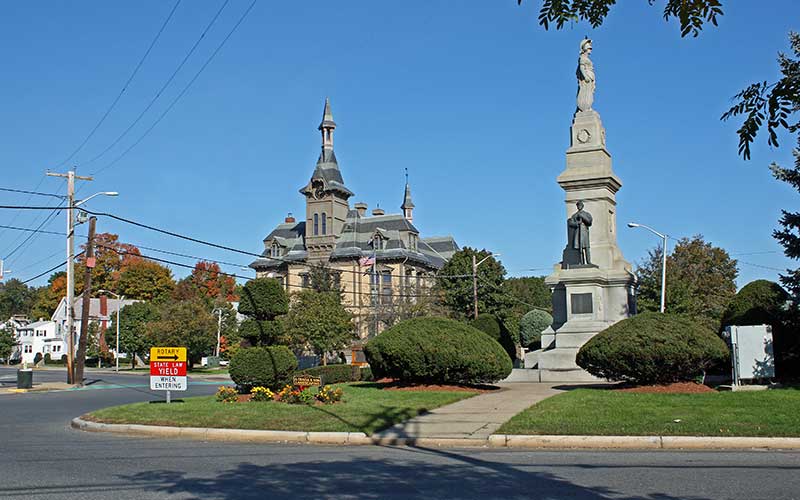
Located just north of Boston, Saugus boasts an historic iron works – and a polluting landfill. In an effort to protect residents and the environment from the hazards posed by landfills, Town Meeting just voted to limit future landfill expansions. Photo: Anthony92931, CC BY-SA 3.0 via Wikimedia Commons
Saugus Town Meeting members have sent a clear message to companies with facilities that pose a danger to public health and the environment: there must be reasonable limits. Last week, Town Meeting voted to approve amendments to Saugus’s zoning by-laws that limit the height of all landfills within the town to 50 feet.
In addition to protecting against unrestricted landfill expansion more broadly, the amendments, which were drafted by citizens with the assistance of CLF staff, will also ensure that Wheelabrator Technologies, Inc., the company that owns and operates the municipal solid waste incinerator and adjacent ash landfill in Saugus, cannot expand beyond its current 50-foot height in the future.
Wheelabrator is currently seeking approval to fill two of the landfill’s valleys – totaling 39 acres – which would extend the facility’s life for another five years. However, to continue operating beyond that point, Wheelabrator would have to expand the landfill’s footprint or height. With no more valleys to fill or land on which to expand, the only option for future growth is up – and these amendments will prevent that from happening.
The Threat to Public Health
Located barely 10 miles north of downtown Boston, Saugus is home to nearly 27,000 people. Town Meeting took this action to protect residents and the environment from the hazards posed by landfills. Wheelabrator’s ash landfill poses a particularly ominous threat because the toxins associated with waste incineration include dioxin, mercury, and lead, which are known to negatively affect the environment and cause or contribute to public health problems such as cancer, reproductive issues, and learning disabilities.
According to Massachusetts Cancer Registry reports for 2007 through 2011, people living in Saugus, as well as the neighboring cities of Lynn and Revere, experienced higher than expected numbers of newly reported cases for many different types of cancer. While these cancer statistics are not directly linked to any particular cause, the fact that local residents are already experiencing high rates of cancer underscores the urgent need to lessen their exposure to any sources of pollutants known to contribute to the disease.
These risks are amplified in the case of Wheelabrator’s facility because more than 50,000 people live within two miles of the toxic landfill. In addition to the ongoing daily exposure to landfill pollution faced by residents, any breach, leak, or spill there poses an immediate and grave danger to public health. And many of the neighborhoods most at risk of contamination from the landfill are environmental justice communities that have already spent decades overburdened by pollution, noise, odors, and other impacts from the waste incinerator and ash landfill.
The Threat to Environmental Health
Beyond public health impacts, Wheelabrator’s ash landfill also threatens the local environment. The landfill is located within the Rumney Marshes Area of Critical Environmental Concern. It’s one of the most biologically significant salt marshes north of Boston. The marsh provides valuable habitat and feeding grounds for fish, shellfish, and a variety of native and migratory birds, as well as significant flood control and protection from storm damage. Under current environmental regulations and policies, Wheelabrator’s ash landfill could never have been built within an Area of Critical Environmental Concern, but the landfill existed before the need to protect the area’s fragile ecosystem was recognized.
Given its coastal location, the ash landfill is also extremely vulnerable to climate change impacts such as erosion from sea level rise and damaging storm surge. A study released last year indicates that sea levels along the Massachusetts coastline (and other areas of New England) are rising faster than in other parts of the world. Throughout New England and beyond, coastal management agencies and public officials are working diligently to identify and minimize environmental and public health risks posed by facilities and infrastructure that will be impacted by climate change – including in the Saugus River watershed. Continual expansion of Wheelabrator’s ash landfill undermines these efforts.
Lessons from the Past Inform Today’s Action
Wheelabrator had tried to convince Town Meeting members to reject the zoning amendments, arguing that a similar effort a decade ago to limit the height of landfills in the town had been overturned in court. Wheelabrator failed to acknowledge a key distinction between that earlier effort and this one, however – the prior amendment would have restricted the height of landfills in the Town to 40 feet, even though Wheelabrator had already obtained approvals to reach 50 feet. Wheelabrator does not, on the other hand, currently have any permission to exceed the newly imposed 50-foot limit.
Restricting Future Growth is Just One Step
Town Meeting’s actions will protect residents and the environment by guarding against unrestricted expansion of landfills within the town, including Wheelabrator’s toxic, unlined, ash landfill.
This is a positive step and one for which CLF applauds Town Meeting. But, while the height restriction will prevent future expansion of the landfill, it doesn’t impact Wheelabrator’s current expansion plan to fill in the site’s remaining valleys and remain open for five more years. The fact is the landfill was supposed to close in 1996, but it has been routinely granted approvals from the state to expand and continue operating, over objections from the town and advocates.
The focus now should be on safely closing and capping Wheelabrator’s landfill and ensuring long-term protection of surrounding communities and ecosystems. Its current expansion plans cannot be allowed to go forward and CLF will be working with community partners to finally shut down this environmental hazard for good.



